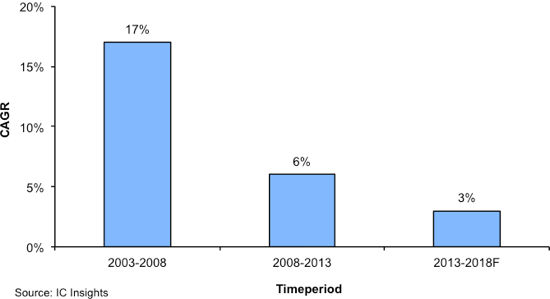Cellphone subscriptions to exceed population in 2015
IC Insights’ 2015 IC Market Drivers Report will be released later this month. The report contains analyses on the IoT, tablet PCs, smartphones, automotive electronics, medical and health systems, wireless networking and many other fast growing electronic systems. One of the most widely reported metrics concerning the cellphone marketplace is the subscriber base, defined as the number of cellular service subscriptions that exist at a given point in time. In 2015, the worldwide population is expected to reach 7.4bn while the number of cellphone subscriptions is forecast to be slightly over 7.5bn (Figure 1), marking the first time cellphone subscriptions will exceed the worldwide population.
In total, the number of cellular subscriptions from 1999-2018 is forecast to have an amazing 19-year CAGR of 16%. It should be noted that in some regions of the world, cellphone subscription penetration rates now greatly exceed 100% of the population (e.g. Russia 185%, Italy 151%, Brazil 141%, Germany 140%, U.K. 128%).
.png)
Figure 1 - Total worldwide cellular subscriptions* (1999-2018F)
One reason that subscriptions exceed a country’s population is that many users purchase different Subscriber Identity Module (SIM) cards and therefore different phone numbers for cities they often visit (to get cheaper phone rates). Each of these SIM cards is considered another 'subscription'. Thus, although the end-of-2014 penetration rate for Russia is expected to be 185%, it is estimated that the true penetration rate (i.e. actual percentage of the population that has a cellphone subscription) will probably be about 70% at the end of this year.
In addition to the effect of SIM cards, there is also an increasing percentage of the population that is carrying two cellphones, typically one for business and one for personal use. Overall, IC Insights currently estimates that there are 4.4bn unique cellphone users in the world today, representing about 60% of the 7.3bn worldwide population in 2014.
There is no denying that a total cellular phone subscription forecast of 7.5bn in 2015 looks impressive. However, as the unique subscriber base in many regions moves toward saturation, the average annual growth rate of unique subscribers is forecast to slow significantly (Figure 2).

Figure 2 - Worldwide unique cellphone subscriber CAGRs
The annual increase in unique cellular phone subscribers is believed to have peaked in 2006 at 362m. Since then, the number of new unique subscribers added to the user base has slowed. IC Insights forecasts that the number of new unique cellular subscribers in 2018 will be only about 100m, less than one-third of the 362m subscribers that were added 12 years earlier.
One trend that will help keep cellphone/smartphone sales strong and partially offset the decline in the growth rate of unique cellular subscribers is the movement of cellphone users to own more than one phone. While multi-phone users are forecast to be a minority portion of the market over the next few years, their numbers will be increasing. In the long run, an increasing number of additional multi-phone cellular subscribers are expected to continue to help boost future cellphone handset sales.
More detailed market forecasts for the total cellphone and smartphone segments through 2018 will be provided in the 2015 IC Market Drivers Report.


